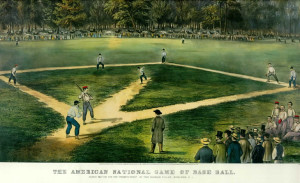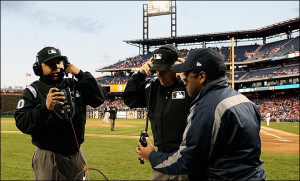The Evolution of Baseball

Though the game of baseball has evolved quite a bit since its early days, there are still many components that are similar.
With the postseason and World Series creeping toward us, many baseball fans get a little nostalgic about the sport. They reflect on the games they watched in the ’70s and ’80s, and they typically lament the direction the game has gone since then.
They aren’t just talking about the attitudes of players or their astronomical incomes. It also applies to the playing of the game itself. Since its inception, baseball has made a remarkable evolution through technology and adaptation. Here are just a few of the ways that it isn’t your grandfather’s game anymore. Whether you like them, hate them, or don’t even understand them, they’re where we are now.
Instant Replay
We might as well get to this one right away, hadn’t we? Baseball has always had a very low-tech nature. Wrigley Field even shunned lights until 1988. Indeed, much of the game’s appeal has always been that even impoverished kids on a rocky vacant lot can cobble together enough basic gear to play.
So it was a bit blasphemous for some fans when Major League Baseball began doing limited video review of certain types of plays. But the fact is, the founders of baseball might have put the technology to use when they first developed the game, if it had been available. As excruciating as it can be to watch an umpire stand there with headphones on for three or four minutes, it’s tough to deny that the mysterious reviewer in New York City is getting most calls right. Win or lose, you can’t argue with that.
Gear In High Gear
With each passing year, the technology behind and within the game becomes more complex. Catcher’s masks are sleek and made of space-age materials. The cleats used today could get you traction on an iceberg.
In perhaps the most dramatic changes, bats have reached an interplanetary level of evolution. The timber swung by DiMaggio and Maris as kids is nothing like youth baseball bats from HomerunMonkey.com, and even the equipment they later used in their professional careers pales in comparison. Sure, pitching is tougher today, but knowing about the bats of the past makes it all the more impressive what those players were able to do.
Statistical Overload
This is not exactly an on-field factor, but it certainly has an impact in the game. Numbers are being crunched at a greater rate than popcorn and Cracker Jacks in modern ball parks. It isn’t enough just to know a player’s batting average or ERA. He also has a slugging percentage, on-base percentage, and a detailed statistical profile of his hitting proficiency on odd-numbered days when the moon is waxing and the temperature is a multiple of 14.
The thing is, these numbers aren’t just tossed around like a pre-game warm up ball. They are actually used. They drive fielder positioning, pitch selection, and base-running predictions.
Whatever their impact, these statistics are only around because of technology. Without computers to rapidly assemble and assimilate these figures, there’s no way they could be developed quickly enough or accessed efficiently enough to be of any use during the game.
Rules In Motion
Much like the equipment, the rules of baseball seem like they ought to stay fairly simple. Ball or strike, safe or out. Who’s got the most runs? Okay. You win.
But with the thousands and thousands of games now in the books, apart from countless hours of practice and film review, managers and players have been able to exploit some loopholes for an advantage. Hence the infield-fly rule, balking, and plate interference, along with many others. It is human nature to look for any advantage you can get, and as the popularity of the game surged (and with it, the salaries of the players), winning became ever more important. The drive to find an edge became stronger, and the rules had to intervene.
The game that came together in Cooperstown, NY has changed in many ways, but it is still remarkably similar to what we view on television each night. We may yet see computerized ball and strike determinations or some kind of genetically engineered wood for bats, but right now America’s pastime is noteworthy in its persistence.

Baseball is very popular game in the world. Mostly people looking this app http://apple.co/1R628Pl for win the 1000$ and also take the lot of hints about sports game.
Basketball has always been the most demanding game that almost every person like to play and see most of the time. I am always taking special interest in the game of football.